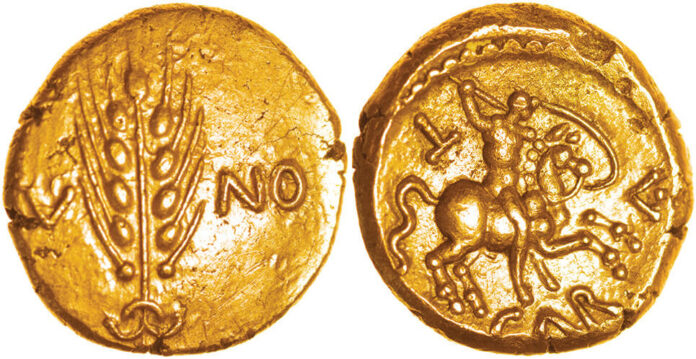
Since the discovery of the unique Caratacus gold stater was announced (Coin News, June and July 2020) much scholarly discussion has been stimulated. That this coin should provoke so much interest is hardly surprising. Caratacus has been famous for two thousand years.
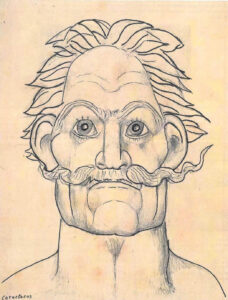
A Famous Freedom Fighter Resisting the Roman Invasion
When he was alive he acquired celebrity status as a freedom fighter. For eight years he resisted the Roman invasion of Britain in AD 43. For eight years he was the most wanted man in the Roman empire, hunted relentlessly from fight to fight, from fort to fort, in the mountains of Wales, until he was betrayed to the Romans in AD 51 by Cartimandua, queen of the Brigantes of Yorkshire, to whom he’d fled for help. By the time he’d been shunted off to Rome in shackles for showcasing, shaming and triumphal butchery, his fame had sped ahead of him, spread through all of Gaul and arrived in Rome before he did.
The emperor Claudius turned this advance publicity to his own advantage. He paraded the manacled Caratacus and his family in public, but instead of executing him as expected, he pardoned him and set him free. Which made him even more of a celebrity, Claudius too. Caratacus remained in Rome, spent a peaceful retirement in Rome and, as far as we know, died some years later in Rome. But his fame lived on and early in the second century AD got a whole new lease of life, thanks to the Roman historian Tacitus who gave a soul-stirring account of Caratacus’s speech as he stood in chains before Claudius and the citizens of Rome. Though posthumously ghosted by Tacitus, either wholly or partly, this speech resounded down the centuries, fanning the flames of Caratacus’s fame. It guaranteed him long-lasting legendary status.
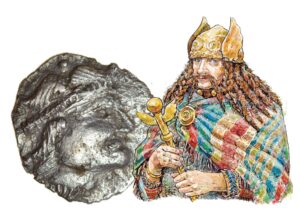
The Legacy of Caratacus
Remembered in medieval Welsh tradition and Welsh legend, Caratacus was later credited with bringing Christianity to Britain and being the father of Pope Linus. He featured in John Fletcher’s play Bonduca (1613), in J.C. Bach’s opera Carattaco (1767), in Elgar’s cantata Caractacus (1898) and, more recently, in various novels and the TV drama Claudius the God. Given his two millennia of international fame – Britain’s first well known freedom fighter and the best known member of Britain’s first famous royal family (his father was Cunobelinus of Colchester, Old King Cole, immortalised as Shakespeare’s Cymbeline) – it is small wonder that when the first-ever gold coin of Caratacus was unearthed it hit the numismatic headlines. David R. Sear, author of Roman Coins and their Values (Spink 2000-2014) and the world’s best known authority on ancient numismatics, says: “This must surely rank amongst the most exciting numismatic discoveries of the 21st century, if not all time.”
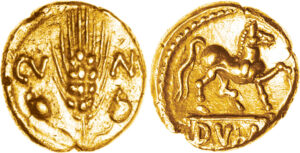
Why Are Caratacus Staters so Rare?
After forty years of intensive metal detecting why has only one gold coin of Caratacus been found? Why so rare? Dr Philip de Jersey, author of Celtic Coinage in Britain (Shire 1996) and Coin Hoards in Iron Age Britain (Spink 2014), says: “The simple fact that it is unique, after all those years of searching and all those thousands of finds, must indicate that it was a rare and unusual coin from the moment it was struck.” Dr John Sills, author of Divided Kingdoms: the Iron Age gold coinage of southern England (Chris Rudd 2017), agrees. He says: “The unique status of the Caratacus stater must mean that very few were minted in the first place.” He suggests that it was “a high status issue struck at the beginning of his reign to cement his authority as a new ruler from a ‘foreign’ dynasty. Caratacus staters may well have been given out to the local aristocracy to show them who was now boss, but it looks as if they didn’t go into general circulation. Two large hoards, Bentworth and Chawton (Coin News, December 2013 and April 2016), end with Epaticcus gold and may be related to the Claudian invasion; if staters of Caratacus passed into circulation they should be present in these finds, but they’re not.”
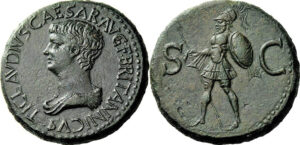
There may be another reason for the great rarity of Caratacus gold staters: of the few that were minted, most were probably converted back into bullion soon after the Claudian invasion. Why? Because if you were found with one in your possession you’d immediately be identified as anti-Roman and, worse still, as a rebel sympathiser. John Sills says: “It was probably unwise for anyone to own a gold coin of the leading resistance leader after the Roman invasion. It would not have been a good idea to be caught by the Romans with a Caratacus stater in your purse.” Isn’t it ironic that a Celtic gold coin that nobody wanted to be found with two thousand years ago is now the gold coin that Celtic collectors most want in their collection?
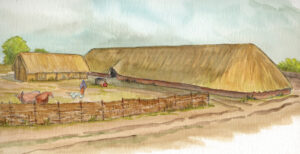
Newly Found Caratacus Stater Sheds Light on Different Aspects of His Life
Current news and views of Caratacus, many sparked by the discovery last November of the unique Caratacus stater, are full of surprises. For example, archaeologist Professor Michael Fulford has recently discovered a huge ditch, 1.5 miles long and up to 4.8 metres deep, that Caratacus may have dug around his capital at Calleva (modern Silchester, Hampshire) to defend it against the Roman invaders (Current Archaeology 356, November 2019). “The find of a gold stater of Caratacus is extremely important”, says Professor Fulford, “in that it adds not only a new dimension to his coinage, otherwise found only in silver, but an insight into the resources he commanded at the time of the Roman invasion of Britain.”
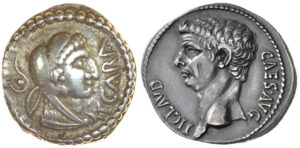
Did Claudius Know Caratacus Personally?
Two more surprises come from numismatist Dr Daphne Nash Briggs, author of Coinage in the Celtic World (Seaby 1987), and archaeologist Reverend Professor Martin Henig, author of The Heirs of King Verica: Culture & Politics in Roman Britain (Amberley 2002). In their forthcoming article ‘Caratacus’ they suggest that Britain’s freedom fighter may have grown up in Rome and met Claudius there. They say: “It is by no means too far fetched to imagine that Caratacus actually did talk to Claudius, both in the Latin he had once learned in Rome, or even in the Celtic tongue which Claudius had imbibed as a child in Lyons. Possibly Claudius had known him personally just as he had known other chieftains’ sons, amongst them Prasutagus, who became federal ruler of the Iceni, and Atrebatic, Gallo-British, Togidubnus, and still retained a friendly feeling towards him.” Their second surprise concerns the poet Martial’s friend, Claudia Rufina ‘the red-head’ (Epigrams XI:53) described by the poet as caeruleis… Britannis edita ‘sprung from the blue Britons’ and who was, as Anthony Birley writes, “doubtless the daughter or granddaughter of a beneficiary of the Roman state; from the period immediately after the conquest” (The People of Roman Britain, Batsford 1970, p.15-16). They say that Rufina “just might have been Caratacus’ daughter” (D.Nash Briggs & M.Henig, ‘Caratacus’, Association for Roman Archaeology News, Autumn 2020). When I told Professor Henig that a gold stater of Caratacus has been found he said: “I am thrilled. This is one of the Celtic coins of the century.”
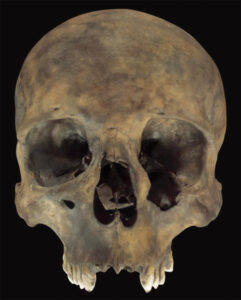
The Academic World Is Thrilled About the Discovery
Similarly effusive comments have been received from other normally reserved scholars. Professor Chris Gosden of the Institute of Archaeology, Oxford, home of the Celtic Coin Index, describes the Caratacus stater as “an amazing coin”. Dr Philip de Jersey, former keeper of the Celtic Coin Index, says: “What an extraordinary coin! Unlike the first ever Volisios Cartivellaunos gold stater, the existence of which had been predicted by Derek Allen in 1944, I don’t think any of us saw this Caratacus stater coming. It seems quite extraordinary after so many decades of metal detecting – of what is after all a diminishing resource – that something quite so unexpected should turn up, and for a ruler who plays such an important role in British history.” Rainer Kretz, an expert in North Thames dynastic coinage and the first person to realise that Dubn (ABC 3008) may have been Caratacus’s brother Togodumnus, says: “Having been struck by a ruler who until now was only known by three silver units and three minims, this represents a truly sensational find. Who, hand on heart, would ever had put his money on a Caratacus stater being found, but against all the odds here it is!” And Dr John Sills, a co-author of Ancient British Coins (Chris Rudd 2010), says it is “the most important single Iron Age coin ever found in this country” (Coin News, July 2020, p.39).
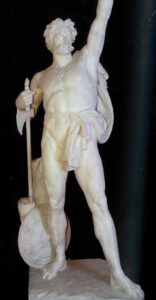
Given the high level of interest that the discovery of the unique Caratacus stater has generated, not to mention the long-standing celebrity status of the prince who produced it, I expect that it will fetch a record price when it comes up for sale on 15 November. Professor Colin Haselgrove, who recently published a report of excavations at Stanwick, Yorkshire, former capital of Queen Cartimandua, who handed Caratacus to the Romans in AD 51, says: “It must be in with a chance of being the most valuable Iron Age coin found to date. Everyone likes a British hero.”
To find out more about Caratacus and the Roman Invasion of Britain, watch this film by History Time.
And here you can read more about Caratacus’ life.
Chris Rudd is a specialist for Iron Age coins in the UK. In 2011 he sold another stater that confirmed a new attribution of this type to Caratacus instead of Cunobelinus.
For more information on Chris Rudd, his firm, or the current auction, please go to the Chris Rudd website.



